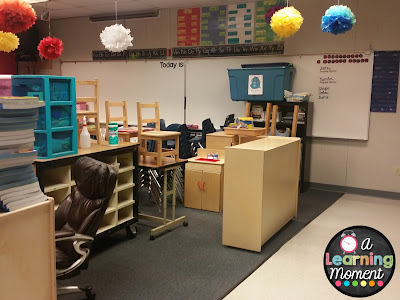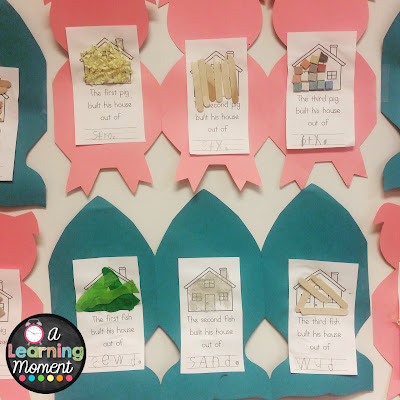Hello!
So we've been super busy in the classroom recently, getting ready for Open House and then Spring Break (which I am currently on) but that still isn't an excuse for being so distant from here! So I've written a few blog posts and will schedule them to post fairly regular so you wont be without some fun news from our classroom!
Anyway, I'm here to talk about my favorite unit that we have covered so far this year (it's actually my favorite that we cover all year long) : Fairy Tales!! My Littles and I have spent that past month learning all about fairy tales and folk tales. We did so many fun activities that came out so awesome!
We started our unit off with talking about common "rules" for both Fairy Tales and Folk Tales. We named specific stories that followed each rule, and then made a big poster showing the rules we needed to classify new stories we were going to read!
The first story we read was Jack and the Giant Beanstalk. This was the perfect way to kick off our unit because the kiddos got to do some science (which seems to be their favorite subject) and they had a "take home" product that parents were really impressed with. We got to grow our very own MAGIC BEANS! We started with a big chart and discussed the three main things our magic beans would need to grow: sun, soil, and water.
The kiddos replicated the chart on a paper plate that I divided into three, and I put that up on our science board. The next day we planted our very own magic beans.


I learned early on that I cannot grow anything to save my life if I have to worry about watering it every day, so now any time I have to grow something for the class I follow this method. I place dry soil in a Styrofoam cup punch a hole in the middle of the soil about an inch deep, place seed in the hole and then lightly cover. (The kiddos did all the this in class.) Then I put some water in the cup until the soil is MOIST, not muddy! Now, here is my trick for making things grow. I take a square of plastic wrap and lay it flat over the top of the cup and then rubber band it to the cup. This creates a greenhouse that will self-water and hold in the heat! I place all the cups in a plastic container and then place them in the sun every day. That's it folks! I don't touch them at all, except to pull them into the classroom for the night. This is how they turned out!


We read Cinderella next and talked a lot about what it might be like if we had a Fairy Godmother. We talked about the wishes we would make, and many students were actually quite concerned about whether or not they could use wishes for other people! I had a bunch of my littles share with the class what they would wish for with a Fairy Godmother, and many asked for toys, some asked for things for their family, and others asked for things for their friends. They were all really excited to share and it made my little teacher heart happy! We did a guided writing assignment (my early birds did one sentence, and my late birds do another) and then completed the craftivity that went with it. My kiddos got to pick the color hand they wanted and the colors for their "magic burst" behind their wands, so those aspects are 100% individual to each student.


My early birds came up with the sentence "I would do magic." They helped me spell everything, and I wrote each letter down just as they told me to spell.
Right now they have select sight words they need to spell correctly, and then they need to focus on the beginning and ending sounds of words. I think they did pretty stinkin' awesome!
My late birds chose to write the sentence "I would give presents." Many students wanted to give presents to specific people, but trying to write so many different people got really complicated so we just settled on giving presents in general.
Again, they are focusing on the beginning and ending sounds with the select sight words being spelled correctly.
After all the writing and gluing was done I went back with glue and glitter and I glittered EVERYTHING! It came out super cute! (Although, I'm still finding glitter all over the room, and the night custodian that cleans the kindergarten wing still hasn't forgiven me. Haha!)
The next activity we worked on was a compare and contrast activity between The Three Little Pigs, and The Three Little Fish.
This was the version of The Three Little Pigs that I read to my littles. It was the perfect way to introduce folk tales since it so clearly followed all the special rules we were looking for.
This story is so adorable! (**I am
NOT sponsored to promote this book at all! I just love it and I use it every year when I do this unit.) It mirrors The Three Little Pigs and is a great way to get young thinkers to compare and contrast two stories! We did a quick compare of the stories and found ways the stories were the same, and we did a contrast to show how the stories were different. The typical differences were the settings and characters since one takes place on land and one takes place in the sea. My littles LOVED talking to each other about the differences between the two stories.
After we compared and contrasted I had my kiddos complete another craftivity that related to each book.
My early birds completed the Three Little Fish craftivity and my late birds completed the Three Little Pigs craftivity. I gave each student actual pieces to identify the materials used to build the houses in each book. I did substitute a few things that I couldn't get a hold of in time (i.e. seaweed and hay/straw) so I used green tissue paper cut into wavy strips for seaweed, and I used yellow present stuffing to simulate straw. If you have those materials available you can use them, although I don't know how seaweed would do with the glue or if it might start to smell. If you try it, let me know how it turns out!
 |
| The students again focused on phonetic spelling. Straw, Sticks, and Bricks. |
 |
| Phonetic spelling of seaweed, sand, and wood. |
Our last big activity we worked on was actually inspired by an AVID lesson I did for some district higher-ups. I have a big theme board that I decorate with every new theme we do. For our AVID lesson I had the kiddos work together to create a castle out of large shapes that had been cut out. They did a great job. The next day I gave them individual sheets of paper and they had to do it on their own. Each castle was unique and beautiful and the kids had so much fun. When they were done creating they needed to come to me and identify how many of each shape they used to create their castle.
**Note: We focus on the four basic shapes: square, rectangle, circle, and triangle, so those are the four shapes on my write up. If you do more, you can always add more or have them verbally identify them!
 |
| Here is the large "theme board" that proudly displays their AVID creations as well as their individual creations. |
As you can see, they all did a wonderful job! Here are a few up close looks at some of the student works:
They are a little blurry but the write up says "To make my fairy tale castle I used ___ squares, ___ rectangles, ___ circles, and ___ triangles." The kiddos were expected to count each shape and then write the number in the correct blank. My kiddos were expected to create their own circles, and for beginners (some of these littles have never even looked at scissors before much less cut with them) I think they did a great job of trying to cut out some circles from some rectangles and square pieces!
I did a few miscellaneous worksheets to tie in Rapunzel, Goldilocks and the Three Bears, and the Princess and the Pea, but weren't nearly as exciting or as engaging as these fun activities.
Well, I hope, if you are ever in the mood for some fairy tale activities that you give some of these a try! My littles loved them and I know yours will too! And I hope, above everything else, that you always remember: Every moment is a learning moment!
Sincerely from TK,








































